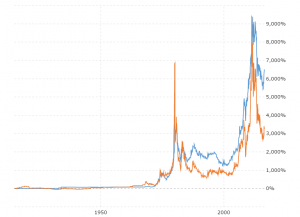Nickel and Dime Your Coin Collection – Part One
To ‘nickel and dime’ someone might be just a nuisance, or of no significance in everyday life, but coin collectors don’t see it that way at all. Collecting nickels and dimes is a serious business, and for small collectors, or on a limited budget, it’s a great way to build an interesting collection of the pocket-change of America over the years. Let’s take a look at the options, because a collection of these small coins is a fascinating thing. Especially today, with the shift away from cash, we could be seeing the end of small denomination coins, making a collection even more interesting, and potentially more valuable.
Nickels and Dimes are easy enough to find for recent years, although coin change is rarely in a good enough condition to satisfy collectors. High-grade examples of coins, especially older dates, are considerably more valuable than worn equivalents, so a good collection will be built on good, clean examples. Let’s take a brief look at nickels, as a guide to what to look for to build a complete collection of this everyday coin. In the second half of this blog we will look at collecting dimes.
Nickels
The first nickel, worth 5 cents, or a 20th of a dollar, was issued by the US Mint in 1866. Made of 75% copper and 25% nickel, it remains the same today as then – .835 inches in diameter, and .077 inches thick. Although its value has fallen every day since it was first minted, The Mint continues to produce many of these coins every year – 1.5 billion a year at last count – at the Denver and Philadelphia Mints. A complete collection of nickels from every year would be missing just three – 1922, 1932, and 1933 – when no nickels were made.
The size and composition of the nickel has remained constant, but the designs on it have changed over the years. There have been four different nickel designs, starting with the first, the Shield nickel, produced between 1866 and 1883. This coin features a shield design on the obverse and the number ‘5’ on the reverse, surrounded by stars and rays. Described by some as the ‘ugliest coin in the world’, it would still have to be an essential part of a complete collection of nickels.
1883 to 1913 were the years of the Liberty Nickel, with its famous Charles Barber profile head of a rather homely Liberty, and the letter V (Roman numeral for ‘5’) on the reverse. This was followed by the even more famous Buffalo or Indian Head Nickel, minted from 1913 to 1938. The obverse is a profile of a Native American, and the reverse is a buffalo, with the words ‘five cents’ below it. The designs were by the famous sculptor of the time, James Earle Fraser. This nickel is the most well-known, and most loved, but interestingly, when it was proposed to replace it in 1938, there was no public outcry, suggesting that the love of this coin came long after it left American pockets. It was replaced by the Jefferson Nickel, and this is the design still being minted today.
The image of Thomas Jefferson on the obverse was created by Felix Schlag, a German-born American, who had served in the German army in Word War I. In 2004 and 2005, the Schlag design was replaced by special designs to celebrate the 100th anniversary of the Lewis & Clarke Expedition, and when the Jefferson nickel returned in 2006, the obverse had changed, from Shlag’s profile to a face-on version by Jamie Franki.
Clearly a collection of nickels has plenty of stories to tell. Next week we will visit the dime.
















